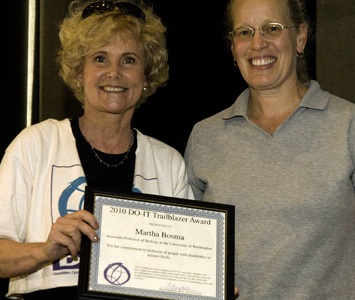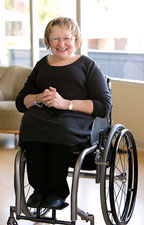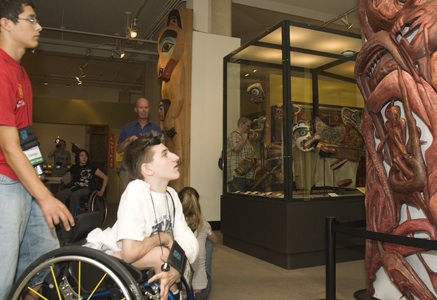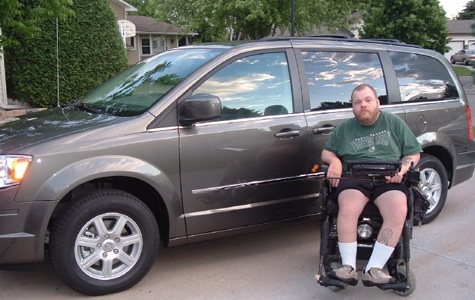DO-IT Scholar: The number one priority for Boeing and any other corporation is making money for the company employees and shareholders, that's what public companies do. I think that including reasoning as to why it would be fiscally beneficial to make airplanes more wheelchair friendly would advance your argument.
DO-IT Scholar: My dad works at the Federal Aviation Administration to make sure airplanes are very safe. I know it's important for all airplane seats to be tied down so they are still attached to the floor in a crash. The seats have a certain shape and size and they bolt to the floor. I don't know if a wheelchair could bolt down enough but it's good to ask.
DO-IT Mentor: Removable seats that make room for a wheelchair sound like a reasonable request and a good idea. It would be similar to the space that is designated for a wheelchair on buses, I guess, with some kind of mechanism to hold the wheelchair in place during takeoff, landing, and turbulence.
DO-IT Ambassador: Detachable chairs and bolted-down wheelchairs are safety issues. What would happen if someone riding a detachable chair perished (or even received injury)? What would happen if something happened to someone in a bolted-down wheelchair? There might be a way to safely do this but it might not be as safe as the current system and the airlines have a right to claim 'undue hardship' if forced to research a way to make this feasible and acceptably safe.
DO-IT Mentor: I'd like to contend that the current system isn't necessarily safe. Riding in an aisle chair (which is how they get a wheelchair user to their seat on planes that are too small for a chair to fit down the aisle) is a very unpleasant experience; I get my side pinched or my elbow banged at least three times each trip. If you're unable to make a transfer by yourself, you have to be lifted into the chair (and again into your seat), which increases chance of injury. Seatbelts and armrests are often in the way during these transfers, increasing chance of injury. Not to mention what damages may occur to your chair while you are out of it.
Sitting in airline seats can also be dangerous for people who need pressure regulating cushions. Placing your own cushion on the airline seat may be helpful, but since the cushion isn't designed to be used in that fashion it might not provide enough protection.
Just last week my friend had to fill out an incident report with an airline because while transporting her in the aisle chair an airline employee pinched her toes against some part of the plane. All of her toes were swollen, and she lost two toenails. Foot injuries can be very serious for someone with her type of disability.
Original Poster: I have a similar experience to yours every time I get on a plane. My family puts blue tape labels on my chair and my brothers let airport workers know where not to lift. But, they never get the message and pretty much lift whatever way they want. My parents watch from their window as the workers shake, push, precariously lift, and otherwise rough-handle the chairs. Luckily, my chair has survived so far.
DO-IT Scholar: My dad works for Boeing and I have asked him the same question. It is just a matter of safety. Tie downs are not nearly as stable as the bolts they use to secure the regular chairs and, you also lose the seat as a flotation device. I'm sure they can come up with some sort of new technology.
DO-IT Scholar: I just flew on a 737 and we had a horrible landing. In a personal wheelchair this would have been very dangerous. However, I know that companies that customize vans for wheelchair users have a huge bolt that hangs on the chair and attaches to the floor of the vehicle. Maybe they could come up with something similar?
I don't like the aisle chair or seats either. I almost fell off the seat several times and it was very uncomfortable.
DO-IT Mentor: Well, this isn't directly related to wheelchair users, but it is related to mobility impairments: my father had Parkinson's disease which, in his case, primarily impacted his ability to walk, turn, get up, and do anything else that involved moving his whole body. As a result, it became increasingly difficult for him to move in and out of a seat on an airplane. Aisle seats were better than others, but not great either. That's just an example of how non-wheelchair users are also impacted by the current system. For him, a seat with more space would have made things easier, and perhaps airlines could accommodate someone with a documented disability without charging extra.
Staff Mentor: There is a program, located at Oregon State University, called the National Center for Accessible Transportation (NCAT), https://cce.oregonstate.edu/transportation-research. If you are interested you can email them at ncat@oregonstate.edu to learn of any current projects. If they are still active this would be a great group to network with.
DO-IT Ambassador: I have been flying commercially for years and I have come across many challenges ranging from the crew considering my power chair to be a bomb; my chair not fitting through the cargo door; and international customs arguments over laws, rules, and regulations. All that said, I do certain things to make my flight easier.
- I put a bright sign on the back of my chair with specific, one-step instructions on how to handle my power chair (how to engage/disengage motors, where to lift the chair, etc.).
- I insist on having my power chair until I personally board the aircraft.
- I insist on speaking personally with the ground crew staff person who is going to be loading my chair onto the aircraft so I can go over exactly how to load my chair. Having a mutual understanding means that that the specific crew member is very likely to take it upon himself/herself to make sure my chair is safe.
- Before my chair is taken, I have the ground crew make sure that a gate delivery tag request is attached.
- Once on the plane, I speak with the head of the cabin crew to make sure as soon as the plane lands, they will contact the ground crew to let them know about my chair and to confirm it will be brought up to the gate of the aircraft so I can leave the jetway.
Be flexible. It is usually not because the crew does not care about power chairs that creates problems. It is usually because of a lack of knowledge. Make sure everyone understands where you are coming from in a respectful manner and they will be respectful to you.








